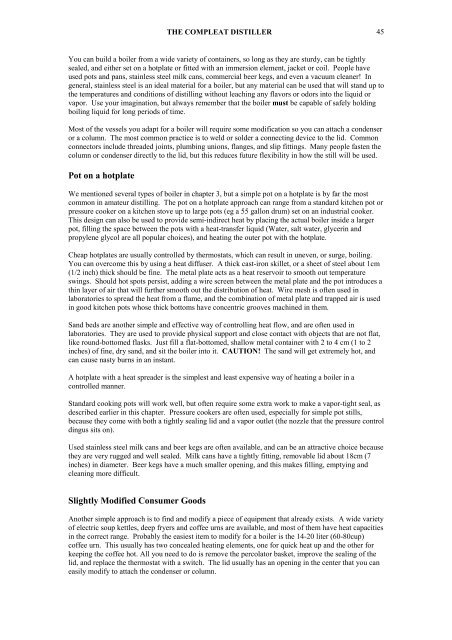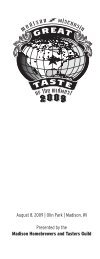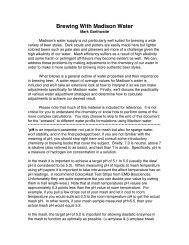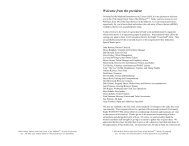The Compleat Distiller
The Compleat Distiller
The Compleat Distiller
You also want an ePaper? Increase the reach of your titles
YUMPU automatically turns print PDFs into web optimized ePapers that Google loves.
THE COMPLEAT DISTILLER 45<br />
You can build a boiler from a wide variety of containers, so long as they are sturdy, can be tightly<br />
sealed, and either set on a hotplate or fitted with an immersion element, jacket or coil. People have<br />
used pots and pans, stainless steel milk cans, commercial beer kegs, and even a vacuum cleaner! In<br />
general, stainless steel is an ideal material for a boiler, but any material can be used that will stand up to<br />
the temperatures and conditions of distilling without leaching any flavors or odors into the liquid or<br />
vapor. Use your imagination, but always remember that the boiler must be capable of safely holding<br />
boiling liquid for long periods of time.<br />
Most of the vessels you adapt for a boiler will require some modification so you can attach a condenser<br />
or a column. <strong>The</strong> most common practice is to weld or solder a connecting device to the lid. Common<br />
connectors include threaded joints, plumbing unions, flanges, and slip fittings. Many people fasten the<br />
column or condenser directly to the lid, but this reduces future flexibility in how the still will be used.<br />
Pot on a hotplate<br />
We mentioned several types of boiler in chapter 3, but a simple pot on a hotplate is by far the most<br />
common in amateur distilling. <strong>The</strong> pot on a hotplate approach can range from a standard kitchen pot or<br />
pressure cooker on a kitchen stove up to large pots (eg a 55 gallon drum) set on an industrial cooker.<br />
This design can also be used to provide semi-indirect heat by placing the actual boiler inside a larger<br />
pot, filling the space between the pots with a heat-transfer liquid (Water, salt water, glycerin and<br />
propylene glycol are all popular choices), and heating the outer pot with the hotplate.<br />
Cheap hotplates are usually controlled by thermostats, which can result in uneven, or surge, boiling.<br />
You can overcome this by using a heat diffuser. A thick cast-iron skillet, or a sheet of steel about 1cm<br />
(1/2 inch) thick should be fine. <strong>The</strong> metal plate acts as a heat reservoir to smooth out temperature<br />
swings. Should hot spots persist, adding a wire screen between the metal plate and the pot introduces a<br />
thin layer of air that will further smooth out the distribution of heat. Wire mesh is often used in<br />
laboratories to spread the heat from a flame, and the combination of metal plate and trapped air is used<br />
in good kitchen pots whose thick bottoms have concentric grooves machined in them.<br />
Sand beds are another simple and effective way of controlling heat flow, and are often used in<br />
laboratories. <strong>The</strong>y are used to provide physical support and close contact with objects that are not flat,<br />
like round-bottomed flasks. Just fill a flat-bottomed, shallow metal container with 2 to 4 cm (1 to 2<br />
inches) of fine, dry sand, and sit the boiler into it. CAUTION! <strong>The</strong> sand will get extremely hot, and<br />
can cause nasty burns in an instant.<br />
A hotplate with a heat spreader is the simplest and least expensive way of heating a boiler in a<br />
controlled manner.<br />
Standard cooking pots will work well, but often require some extra work to make a vapor-tight seal, as<br />
described earlier in this chapter. Pressure cookers are often used, especially for simple pot stills,<br />
because they come with both a tightly sealing lid and a vapor outlet (the nozzle that the pressure control<br />
dingus sits on).<br />
Used stainless steel milk cans and beer kegs are often available, and can be an attractive choice because<br />
they are very rugged and well sealed. Milk cans have a tightly fitting, removable lid about 18cm (7<br />
inches) in diameter. Beer kegs have a much smaller opening, and this makes filling, emptying and<br />
cleaning more difficult.<br />
Slightly Modified Consumer Goods<br />
Another simple approach is to find and modify a piece of equipment that already exists. A wide variety<br />
of electric soup kettles, deep fryers and coffee urns are available, and most of them have heat capacities<br />
in the correct range. Probably the easiest item to modify for a boiler is the 14-20 liter (60-80cup)<br />
coffee urn. This usually has two concealed heating elements, one for quick heat up and the other for<br />
keeping the coffee hot. All you need to do is remove the percolator basket, improve the sealing of the<br />
lid, and replace the thermostat with a switch. <strong>The</strong> lid usually has an opening in the center that you can<br />
easily modify to attach the condenser or column.









